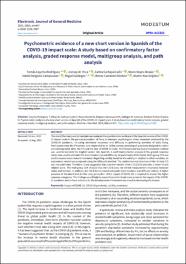Mostrar el registro sencillo del ítem
Psychometric evidence of a new short version in Spanish of the COVID-19 impact scale: A study based on confirmatory factor analysis, graded response model, multigroup analysis, and path analysis
| dc.contributor.author | Caycho-Rodríguez , Tomás | es_ES |
| dc.contributor.author | Vilca, Lindsey W. | es_ES |
| dc.contributor.author | Carbajal-León, Carlos | es_ES |
| dc.contributor.author | Reyes-Bossio, Mario | es_ES |
| dc.contributor.author | Delgado-Campusano, Mariel | es_ES |
| dc.contributor.author | Gallegos, Miguel | es_ES |
| dc.contributor.author | Carranza Esteban, Renzo | es_ES |
| dc.contributor.author | vNoe-Grijalva, Martin | es_ES |
| dc.date.accessioned | 2022-11-21T16:48:53Z | |
| dc.date.available | 2022-11-21T16:48:53Z | |
| dc.date.issued | 2022-08-20 | |
| dc.identifier.uri | https://hdl.handle.net/20.500.13053/7163 | |
| dc.description.abstract | “The aim of the study was to translate and evaluate the psychometric evidence of the Spanish version of the COVID19 impact scale in the general population of Peru, to measure psychological stress responses produced by the COVID-19 pandemic, including emotional responses and difficulty in performing activities of daily living. Participants were 601 Peruvians, who responded to an online survey consisting of questions designed to collect sociodemographic data, the CIS and the fear of COVID-19 scale. The forward and backward translation method was used to translate the English version into Spanish. A confirmatory factor analysis (CFA), graded response model was used to estimate the discrimination (a) and difficulty (b) parameters of the items. Multi-group CFA was used to assess measurement invariance. Regarding validity based on the validity in relation to other variables, an explanatory model was proposed using the SEM path method. The unidimensional structure of the 10-item CIS was not confirmed. Therefore, it was suggested that a six-item model of the CIS (CIS-6) provides a better fit and reliable score. The multigroup CFA showed that the CIS-6 does not exhibit measurement invariance between males and females. In addition, the CIS-6 items present adequate discrimination and difficulty indices. A higher presence of the latent trait (in this case, perception of the impact of COVID-19) is required to answer the higher response categories. The findings would help to assess those individuals more prone to the impact of the COVID19 pandemic and to have evidence for the development of interventions aimed at decreasing the impact.“ | es_ES |
| dc.format | application/pdf | es_ES |
| dc.language.iso | eng | es_ES |
| dc.publisher | MODESTUM LTD | es_ES |
| dc.rights | info:eu-repo/semantics/openAccess | es_ES |
| dc.rights.uri | https://creativecommons.org/licenses/by/4.0/ | es_ES |
| dc.subject | impact of COVID‑19, COVID‑19 pandemic, validity, invariance | es_ES |
| dc.title | Psychometric evidence of a new short version in Spanish of the COVID-19 impact scale: A study based on confirmatory factor analysis, graded response model, multigroup analysis, and path analysis | es_ES |
| dc.type | info:eu-repo/semantics/article | es_ES |
| dc.identifier.doi | https://doi.org/10.29333/ejgm/12388 | es_ES |
| dc.type.version | info:eu-repo/semantics/publishedVersion | es_ES |
| dc.publisher.country | GB | es_ES |
| dc.subject.ocde | http://purl.org/pe-repo/ocde/ford#3.03.00 | es_ES |
Ficheros en el ítem
Este ítem aparece en la(s) siguiente(s) colección(es)
-
Web of Science (WOS) [236]


